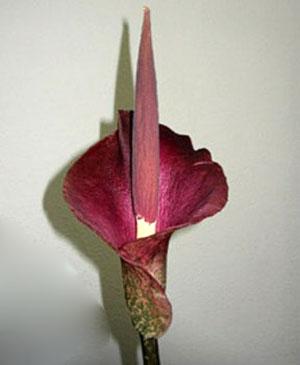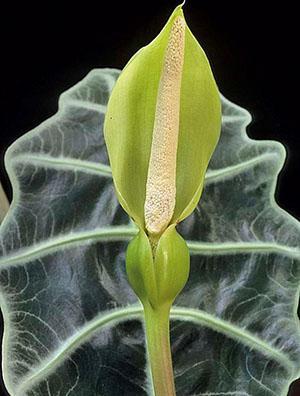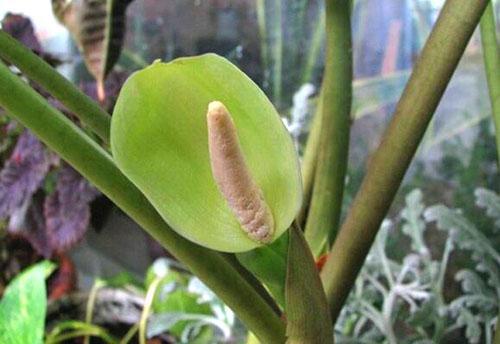Let's get to know the alocasia flower
 The meaning of the existence of any species in nature lies in the continuation of the genus. Alocasia in natural conditions can multiply by all available methods - vegetative, offspring from roots, seeds. It is possible to transfer and conquer new territories only by seed reproduction. Therefore, alocasia flower in nature is a normal physiological process. At home, approaching extreme, flowering is not always possible. It is all the more pleasant to reach heights in caring for a fussy.
The meaning of the existence of any species in nature lies in the continuation of the genus. Alocasia in natural conditions can multiply by all available methods - vegetative, offspring from roots, seeds. It is possible to transfer and conquer new territories only by seed reproduction. Therefore, alocasia flower in nature is a normal physiological process. At home, approaching extreme, flowering is not always possible. It is all the more pleasant to reach heights in caring for a fussy.
Blooming alocasia at home

Giving strength to flowering, and then for seed ripening, if pollination occurs, the alocasia flower loses its decorative effect. Leaves begin to fall off, a dry stem with a rhizome remains. Perhaps, after a long time after insemination, the plant will recover if a competent florist takes it to a cool room to rest for several months.
Read also the article: fuchsia cultivation and care at home, reproduction pruning!
 Blooming alocasia at home happens more often if a showcase is built for it, in which the climate of the humid tropics is simulated. In living quarters, such an atmosphere is impossible. Some types of ornamental deciduous plants sometimes emit an ear, others never bloom.
Blooming alocasia at home happens more often if a showcase is built for it, in which the climate of the humid tropics is simulated. In living quarters, such an atmosphere is impossible. Some types of ornamental deciduous plants sometimes emit an ear, others never bloom.
Alocasia flower structure
 Plants that have reached the age of 5-7 years bloom. At the same time, in flowers with falling leaves, a peduncle appears simultaneously with a young leaf. The petiole is always longer than the peduncle. The coverlet tightly wraps a developing flower like in a cocoon, gradually making room for its appearance. The cover leaves as the flower unfolds, but falls off only with the maturation of the seeds.
Plants that have reached the age of 5-7 years bloom. At the same time, in flowers with falling leaves, a peduncle appears simultaneously with a young leaf. The petiole is always longer than the peduncle. The coverlet tightly wraps a developing flower like in a cocoon, gradually making room for its appearance. The cover leaves as the flower unfolds, but falls off only with the maturation of the seeds.
The ear is a small inflorescence with short legs, they are attached to the body. The ear is divided into female and male zones. Closer to the base, the thickened part is female. The male area is a cylindrical top.
 Flowers are monoecious. Male stamens consist of accrete stamens in reverse pyramidal synandria. In the female flower, the stigma is short with 3-4 lobes. After pollination, several berries of ruby or orange color are formed on the cob, each of which bears several seeds.
Flowers are monoecious. Male stamens consist of accrete stamens in reverse pyramidal synandria. In the female flower, the stigma is short with 3-4 lobes. After pollination, several berries of ruby or orange color are formed on the cob, each of which bears several seeds.
Proper care of alocasia flower allows the plant to propagate without depletion due to flowering. Moreover, the seeds do not convey all the properties of the mother bush. Flowering will be short-lived, and the aroma is not for everybody. The peduncle can be carefully removed. If the time has come for the flowering of alocasia, the peduncle has appeared, you should decide for yourself which is better, the beauty of a mature plant or its flowering with consequences.
Alokazia care tricks
 The culmination of the grower's efforts to care for houseplants is their flowering. Therefore, to achieve flowering even decorative pets with large leaves is always a task for the master. On numerous forums of florists, there are many tips and happy owners show photos of alocasia flowers.There are those who show the consequences of obtaining seeds from their pets.
The culmination of the grower's efforts to care for houseplants is their flowering. Therefore, to achieve flowering even decorative pets with large leaves is always a task for the master. On numerous forums of florists, there are many tips and happy owners show photos of alocasia flowers.There are those who show the consequences of obtaining seeds from their pets.
The main stimulus for flowering is considered to be two mutually exclusive aspects. It is necessary to create the desired microclimate, humidity and nutrition, on the one hand. On the other hand, dry the adult plant for a short time before the onset of spring. Such a trick for caring for alocasia will shake it up and force it to provide for the continuation of the genus by seeds, since the roots became uncomfortable in this place. And then the rudiment of a flower will be tied. Further good care will no longer stop the development of the cob.
Basic rules for the care of alocasia
 In order for the alocasia flower to prosper and bring pleasure from contemplation, it is necessary to observe the conditions for its maintenance:
In order for the alocasia flower to prosper and bring pleasure from contemplation, it is necessary to observe the conditions for its maintenance:
- A bright place of detention without direct sunlight and no drafts.
- Summer temperature 22-27 degrees, winter not lower than 18.
- Humidity is about 80% in summer, slightly less in winter. But if you do not wait for flowering, then the plant can be content with 50% if there is an aquarium nearby, a pallet with wet expanded clay, a substrate of moss and wood chips.
- Watering systematic, but without waterlogging of the soil and without stagnant water in the drainage pan. In winter, watering is rare, once a week, depending on the condition of the soil. The water is used soft, settled.
- Spraying water over the plant in the form of a mist, wiping the leaves with a soft cloth, once a week a warm shower in the bathroom, followed by removing excess moisture.
- Fertilization of alocasia once every 2 weeks in summer and monthly in winter with complex formulations. For adult plants you need potash-nitrogen mixture with micronutrient fertilizers and stimulants, young people need additionally monophosphate, a soluble microfertilizer.
- Timely transplanting the plant into a tall, cramped container that maintains stability. The soil is selected light, slightly acidic, with a large mineral component.
- Systematic control of plant health, absence of pests and diseases.
 If all the conditions for a plant are created, then it will prosper, delighting with its decorative effect. For alocasia flowering, create a stressful situation, but for a short time. If you put a plant in a warm showcase or florarrium, then it will be much easier to provide tropical conditions there, to warm up the earth.
If all the conditions for a plant are created, then it will prosper, delighting with its decorative effect. For alocasia flowering, create a stressful situation, but for a short time. If you put a plant in a warm showcase or florarrium, then it will be much easier to provide tropical conditions there, to warm up the earth.
 For beginner growers, advice on creating favorable care for alocasia flower and fertilizers for it will also be valuable. It is advised not to regret adding vermiculite to the soil by almost half. The dignity of the mineral, it picks up excess moisture and gradually gives it away, regulating the moisture in the pot. Perlite disinfects and structures the soil. The best organic fertilizer there will be shavings of animal horns, it acts more effectively than vermiculite. For the development of the root system, you can use Domotsvet, and in winter it is imperative to feed Ferrovit together with Emerald. They provide better absorption of oxygen in a lack of light.
For beginner growers, advice on creating favorable care for alocasia flower and fertilizers for it will also be valuable. It is advised not to regret adding vermiculite to the soil by almost half. The dignity of the mineral, it picks up excess moisture and gradually gives it away, regulating the moisture in the pot. Perlite disinfects and structures the soil. The best organic fertilizer there will be shavings of animal horns, it acts more effectively than vermiculite. For the development of the root system, you can use Domotsvet, and in winter it is imperative to feed Ferrovit together with Emerald. They provide better absorption of oxygen in a lack of light.
Flowering of various types of alocasia
 A short plant with pink-green petioles and dark green leaves with bright streaks. Peduncle up to 20 cm, cob white-pink, up to 10 cm, veil twice as long. It blooms, but does not set seeds indoors.
A short plant with pink-green petioles and dark green leaves with bright streaks. Peduncle up to 20 cm, cob white-pink, up to 10 cm, veil twice as long. It blooms, but does not set seeds indoors.
Alocasia large-rooted, grows up to 2 m in height, medicinal type. peduncle up to 30 cm, ear up to 24 cm, bedspread of the same size. The berries are red, shiny up to 1 cm in section.
Alocasia is copper-red, a very decorative compact plant, leaves are convex, leathery with a metallic sheen. Flowers have an unpleasant specific smell. Peduncles are dark red, up to 15 cm, the same cover. There are no seeds at home.
 This type of alocasia most often blooms at home. Black velvet, or black velveteen, is a short plant that is loved for the special softness of its chic leaves. Peduncle up to 10 cm long, white-pink veil, less peduncle.
This type of alocasia most often blooms at home. Black velvet, or black velveteen, is a short plant that is loved for the special softness of its chic leaves. Peduncle up to 10 cm long, white-pink veil, less peduncle.
 Many species of the amazing alocasia flower are waiting to be described. Our task is to show the diversity of the world of domestic plants. Everyone chooses his favorite flower at the behest of his heart, and he becomes a member of the family.
Many species of the amazing alocasia flower are waiting to be described. Our task is to show the diversity of the world of domestic plants. Everyone chooses his favorite flower at the behest of his heart, and he becomes a member of the family.